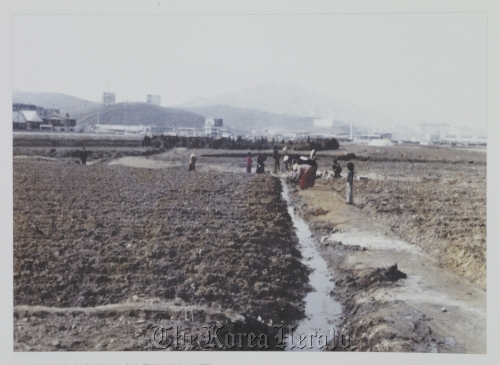Exhibition looks back at 40 years of Gangnam development
Packed with high-priced apartments, prestigious schools, corporate banks, nightclubs and plastic surgery clinics, Gangnam was nothing more than farmland just 40 years ago.
The Seoul Museum of History’s newly launched exhibition, “40 Years of Gangnam, Exponential Growth,” follows the dramatic developmental change of the present-day metropolitan district located south of the Han River.
Back in the 1960s, northern Seoul was experiencing explosive population growth along with its industrialization. Soon, its developmental expansion to the south became inevitable, as the increased population demanded more housing.
The Hannam Bridge, which connects Yongsan of northern Seoul to Apgujeong-dong in Gangnam was opened in 1969. The following year, the Gyeongbu Expressway, connecting Seoul to Busan, was launched in Gangnam’s Seocho-gu. From then on, the district ― which used to be called Yeongdong, meaning east of Yeongdeunngpo-gu of southwest Seoul ― transformed itself to the center of Seoul’s economy, culture and education.

Packed with high-priced apartments, prestigious schools, corporate banks, nightclubs and plastic surgery clinics, Gangnam was nothing more than farmland just 40 years ago.
The Seoul Museum of History’s newly launched exhibition, “40 Years of Gangnam, Exponential Growth,” follows the dramatic developmental change of the present-day metropolitan district located south of the Han River.
Back in the 1960s, northern Seoul was experiencing explosive population growth along with its industrialization. Soon, its developmental expansion to the south became inevitable, as the increased population demanded more housing.
The Hannam Bridge, which connects Yongsan of northern Seoul to Apgujeong-dong in Gangnam was opened in 1969. The following year, the Gyeongbu Expressway, connecting Seoul to Busan, was launched in Gangnam’s Seocho-gu. From then on, the district ― which used to be called Yeongdong, meaning east of Yeongdeunngpo-gu of southwest Seoul ― transformed itself to the center of Seoul’s economy, culture and education.


The exhibition consists of three parts: the historical accounts of Gangnam’s past 40 years; maps, videos and graphics of the district; and a series of photos of diverse sites of Gangnam, including COEX, a Daechi-dong street filled with private academic institutes, countless plastic surgery clinics in Sinsa-dong, and high-end, luxurious shopping districts in Cheongdam-dong and Apgujeong-dong.
The photo exhibition, in particular, showcases both positive and negative aspects of Gangnam, resulted from its rapid and exponential development.
Land prices in Gangnam skyrocketed as the Hannam Bridge and the Gyeongbu Expressway opened 1969 and 1970. Along with price rises, countless real estate agencies gathered in Gangnam, and real estate speculation increased dramatically in the 1970s and 1980s.
In 1972, the municipal government officially banned construction of new buildings in northern Seoul. As a result, many bars, nightclubs and other places of entertainment moved to Gangnam, where no taxes and regulations existed at the time. This was the beginning of the popular, present-day entertainment district in Sinsa-doing and Apgujeong-dong, where many young people enjoy the nightlife.
In the 1970s, many prestigious schools that were located Jongno of Northern Seoul also moved to Gangnam, blaming the old school facilities and not enough land to expand their school grounds. In 1976, Gyeonggi High School moved to Samseong-dong of Gangnam. In the following years, Huimoon High School, Seoul High School and Sookmyung Girls’ High School moved to Gangnam. These schools, along with a few others, soon established themselves as one of the most well-known, prestigious schools in Seoul, and triggered many pricey private tutoring institutions to gather in the area.
In the 1990s, the National Library of Korea and Seoul Arts Center opened in Gangnam.
The district’s population tripled from 320,000 in 1975 to 950,000 in 1995.
The exhibition runs through Feb. 27. For more information, call (02) 724-0150.
By Claire Lee (clairelee@heraldcorp.com)









![[Kim Seong-kon] Democracy and the future of South Korea](http://res.heraldm.com/phpwas/restmb_idxmake.php?idx=644&simg=/content/image/2024/04/16/20240416050802_0.jpg&u=)







![[KH Explains] Hyundai's full hybrid edge to pay off amid slow transition to pure EVs](http://res.heraldm.com/phpwas/restmb_idxmake.php?idx=652&simg=/content/image/2024/04/18/20240418050645_0.jpg&u=20240418181020)

![[Today’s K-pop] Zico drops snippet of collaboration with Jennie](http://res.heraldm.com/phpwas/restmb_idxmake.php?idx=642&simg=/content/image/2024/04/18/20240418050702_0.jpg&u=)